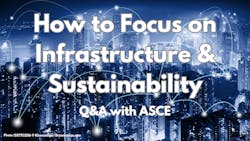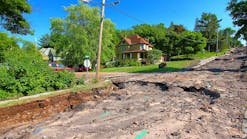In early May, the American Society of Civil Engineers (ASCE) released a new publication, “Integrating Resilience and Sustainability into Civil Engineering Projects.” The publication brings to light infrastructure and resiliency and how “the engineering community is working to integrate social science, policy, and economics into the planning, design, and management decisions surrounding physical infrastructure projects,” an ASCE press released said.
To better understand the findings in this publication, Stormwater Solutions Editor-in-Chief Katie Johns asked the publication’s authors, Caroline Field and Chris Zawislak, a few questions.
KJ: Where did the concept for this publication come from?
CF & CZ: When ASCE founded the Infrastructure Resilience Division, it was found there was a need to better understand what resilience and sustainability meant to the profession. Both were seemingly buzzwords used interchangeably. The Social Science, Policy, Economics, Education (SPEED) Committee sought to clarify this understanding and evaluate the roots of both concepts and then deliver an understanding in the form of the project process.
KJ: Can you walk us through your research for this publication?
CF & CZ: It cannot be understated how the diverse experiences of our team played an integral part in the formation of this publication. The team included members inside and out of the profession who each brought their own research and understanding into the project meetings. Using an initial survey of ASCE members on what resilience and sustainability meant to them, our team then expanded into lively discussions of those concepts based on our practices and research. Each section of this paper, and its associated examples were distilled from these conversations and written by the subject matter experts.
KJ: Why is it so important to incorporate sustainability and resiliency into projects?
CF & CZ: As the paper lays out, we are in a Volatile, Uncertain, Complex, and Ambiguous (VUCA) world. Infrastructure projects are long-term investments that need to be planned, designed, constructed, and decommissioned in ways that they both stand the tests of the VUCA world over its life but also minimize negative impacts to the environment. This paper addresses key considerations of each phase of an infrastructure's life to ensure both outcomes.
KJ: What do you think is the biggest challenge to integrating resiliency and sustainability in civil engineering projects?
CF & CZ: Funding. It is often said that our priorities are reflected not in words but in money. This doesn't mean you cannot achieve a resilient and/or sustainable result for low costs but there needs to be an understanding that not investing in these concepts will have externalized costs for individuals and society.
KJ: What is a piece of advice you can give to engineers on implementing resiliency and sustainability into their projects?
CF & CZ: It is important to ensure stakeholders understand the importance of why projects should implement resilience and sustainability. There are risks and costs that need to be weighed, and as engineers we are often trusted advisors who should be able to clearly communicate the importance of long-term planning in our infrastructure investments.
KJ: What are the biggest misconceptions about resiliency and sustainability and can you address them?
CF & CZ: That one is more important than the other or that one subsumes the other. We hope a takeaway from our readers is that the principles of resilience and sustainability can work together for the benefit of all.






